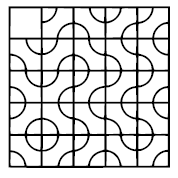| ENG RUS | Timus Online Judge |
1947. MeanderTime limit: 1.0 second Memory limit: 64 MB  Robot Grand Master E2E4 lost disgracefully in 128th-finals of the Galaxy
Meander Championships. He practically won the party, but then made an incredible
mistake: he simply didn’t notice the winning move! Inspired by this mistake
his counterpart used the opportunity and won. It seems that some piece of
E2E4’s artificial brain started hiccupping. Will you manage to help the
robot quickly so that he never loses meander games in this shameful way? To play meander, 24 square tiles are used. They are laid out on the
square board of 25 squares so that one square is always unoccupied. If one
looks at the board from above, he can see that 12 tiles have pattern
of the first type, and the other 12 tiles have pattern
of the second type (see the picture on the right).
Example initial position is shown in the picture.  Players make moves in turns. In one move a player can simultaneously move
one, two, three or four tiles along one of the sides of the playing board.
Tiles are moved on the surface of the board, they can’t be turned. The
game goes on until one of the players wins by making a pattern in
which at least three tiles form a solid line connecting two edges of the
board (either opposite or adjacent). Such a
pattern is shown in the picture on the left (the line connects the left
and the bottom edges of the board). Write a program which defines if the specified pattern is winning, and
if not, whether there exists a winning move. InputInput data represents five lines each containing five symbols. Symbol “*”
marks an empty square. Symbol “/” marks the pattern of the first type,
and symbol “\” marks the pattern of the second type.
It is guaranteed that the input data contains exactly one symbol “*”,
12 symbols “/”, and 12 symbols “\”. OutputOutput “WIN” if the pattern is already winning. If it is not winning, but
there is a move that makes it so, print this move. The move is
described with two symbols: the first one specifies the direction of the move
(“L” is left, “R” is right, “D” is down, “U” is up), and the second one specifies
the amount of the tiles moved (from 1 to 4). For example, “U2” means
“Move two tiles up”. If there are several moves, making the
specified pattern winning, output any of them. If the pattern is not
victorious and it cannot be made victorious in one move, output “FAIL”. Samples
Problem Author: Andrey Demidov Problem Source: Open Ural FU Personal Contest 2012 Tags: none |
